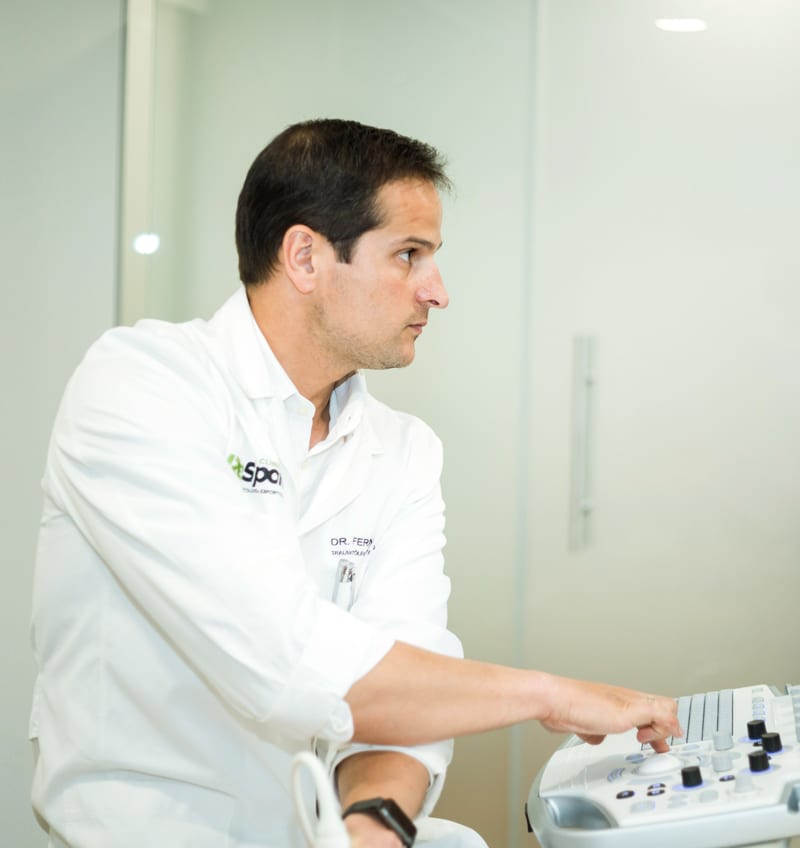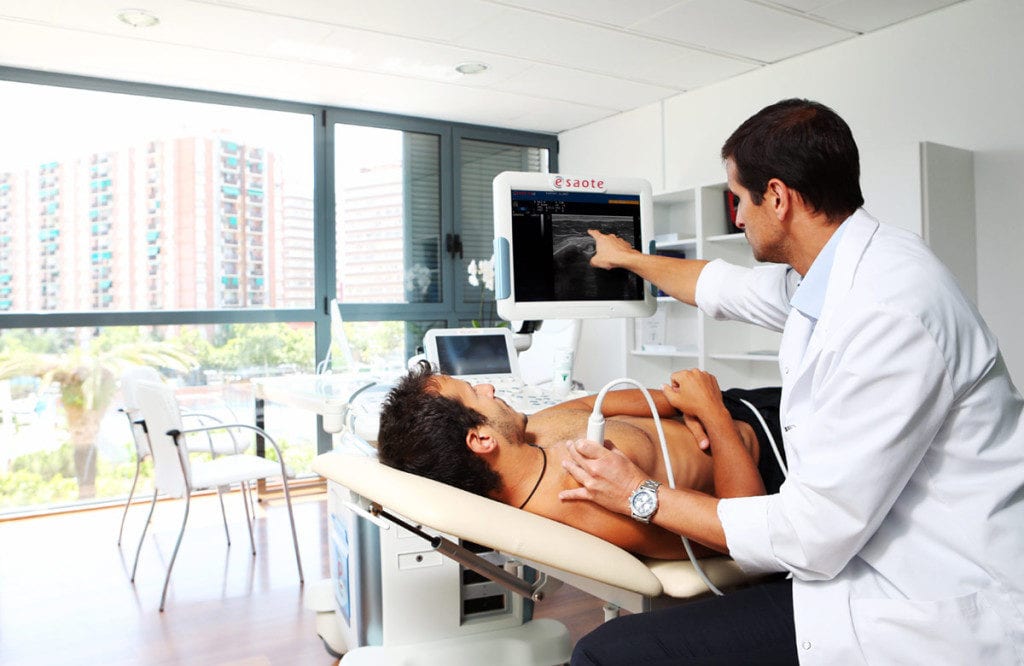
Ferran Abat González
Traumatólogo deportivo
Profesionalmente me defino como especialista en traumatología deportiva y cirugía ortopédica, especialmente en el tratamiento y cirugía de lesiones de músculo y tendón, además de ponente en congresos internacionales.
He escrito múltiples artículos para revistas médicas internacionales como The American Journal of Sports Medicine o KSSTA – The official journal of ESSKA, así como diversos capítulos de libros sobre traumatología deportiva.

Soy fundador y director médico de ReSport Clinic, un centro avanzado de traumatología deportiva interdisciplinaria en Barcelona.

La suma de años de experiencia, investigación y divulgación han hecho que la comunidad médica me considere un referente mundial en la técnica de la Electrólisis Ecoguiada (USGET) con anestesia.
Trabajar con ecografía musculo-esquelética, con la Electrólisis Eco-guiada, factores de crecimiento, entre otras técnicas, no sólo me ha permitido ofrecer un diagnóstico correcto, sino que también me ha ayudado a desarrollar tratamientos que logran una recuperación rápida y completa, incluso en aquellos que han llegado a renunciar al deporte.
Personalmente me defino como barcelonés de nacimiento y aunque he residido en muchas ciudades Europeas durante mi formación, me siento fuertemente ligado al mar Mediterráneo. Soy una persona activa, tranquila y familiar, esposo de Thaïs y padre de Ferran y Martina; apasionado del deporte en general (participo en competiciones siempre que mis responsabilidades me lo permiten) y del pádel, que disfruto con mis amigos en partidos que suelen acabar en barbacoa.
Tengo la convicción de que el deporte puede hacer de este mundo un lugar mejor, y mi visión es la de una comunidad de deportistas con sólidos valores y consciente y respetuoso con las capacidades físicas de cada uno, capacidades que se pueden potenciar, pero sobre todo cuidar.
Publicaciones científicas:
A continuación comparto algunas de las publicaciones y artículos científicos más relevantes:
- Capsular fixation limits graft extrusion in lateral meniscal allograft transplantation. Int Orthop. 2019. Nov;43(11):2549-2556. doi: 10.1007/s00264-019-04398-8. Epub 2019 Aug 23.
- Confirmatory factor analysis of VISA-P scale and measurement invariance across sexes in athletes with patellar tendinopathy. J Sport Health Sci. 2017 Sep;6(3):365-371. doi: 10.1016/j.jshs.2016.01.020.
- Current trends in tendinopathy: consensus of the ESSKA basic science committee. Part II: treatment options. J Exp Orthop. 2018 Sep 24;5(1):38. doi: 10.1186/s40634-018-0145-5.
- Clinical factors that affect perceived quality of life in arthroscopic reconstruction for acromioclavicular joint dislocation. Rev Esp Cir Ortop Traumatol. 2018 Mar – Apr;62(2):121-126. doi: 10.1016/j.recot.2017.10.006.
- All-Suture Repair for Compressive Rotator Cuff Tears: Reducing the Traction of the Tissue. Arthrosc Tech. 2017 Apr 24;6(2):e499-e503. doi: 10.1016/j.eats.2016.11.005.
- Current trends in tendinopathy: consensus of the ESSKA basic science committee. Part I: biology, biomechanics, anatomy and an exercise-based approach. J Exp Orthop. 2017 Dec;4(1):18. doi: 10.1186/s40634-017-0092-6.
- Randomized controlled trial comparing the effectiveness of the ultrasound-guided galvanic electrolysis technique (USGET) versus conventional electro- physiotherapeutic treatment on patellar tendinopathy. J Exp Orthop. 2016 Dec;3(1):34. Epub 2016 Nov 16.
- Femoral Tunnel Drilling Angles for Posteromedial Corner Reconstructions of the Knee. Arthroscopy. 2015 Sep;31(9):1764-71. doi: 10.1016/j.arthro.2015.03.007.
- An experimental study of muscular injury repair in a mouse model of notexin-induced lesion with EPI technique. BMC Sports Sci Med Rehabil. 2015 Apr 17;7:7. doi: 10.1186/s13102-015-0002-0.
- Biomechanical analysis of acromioclavicular joint dislocation repair using coracoclavicular suspension devices in two different configurations. J Orthop Traumatol. 2015 Sep;16(3):215-9. doi: 10.1007/s10195-015-0346-y.
- Anatomic reconstruction of chronic coracoclavicular ligament tears: arthroscopic-assisted approach with nonrigid mechanical fixation and graft augmentation. Arthrosc Tech. 2014 Sep 15;3(5):e583-8. doi: 10.1016/j.eats.2014.06.014.
- Effectiveness of the Intratissue Percutaneous Electrolysis technique and isoinertial eccentric exercise in the treatment of patellar tendinopathy at two years follow-up. Muscles Ligaments Tendons J. 2014 Jul 14;4(2):188-93.
- Giant cell tumour of bone: a series of 97 cases with a mean follow-up of 12 years. Rev Esp Cir Ortop Traumatol. 2015 Jan-Feb;59(1):59-65. doi: 10.1016/j.recot.2014.06.005.
- Molecular repair mechanisms using the Intratissue Percutaneous Electrolysis technique in patellar tendonitis. Rev Esp Cir Ortop Traumatol. 2014 Jul-Aug;58(4):201-5. doi: 10.1016/j.recot.2014.01.002.
- Fracture of the carpal scaphoid in children. Case report and literature review. Acta Ortop Mex. 2013. Sep-Oct;27(5):335-8.
- Clinical results after ultrasound-guided intratissue percutaneous electrolysis and eccentric exercise in the treatment of patellar tendinopathy. Knee Surg Sports Traumatol Arthrosc. 2015 Apr;23(4):1046-52. doi: 10.1007/s00167-014-2855-2.
- Reliability of preoperative measurement with standardized templating in Total Knee Arthroplasty. World J Orthop. 2013 Oct 18;4(4):287-90. doi: 10.5312/wjo.v4.i4.287.
- Promising short-term results following selective bundle reconstruction in partial anterior cruciate ligament tears. Knee. 2013 Oct;20(5):332-8. doi:10.1016/j.knee.2013.05.006.
- The snapping scapula as a sympton of a tumor in the scapulothoracic region]. Rev Esp Cir Ortop Traumatol. 2013 Mar-Apr;57(2):123-8. doi: 10.1016/j.recot.2012.12.005.
- Elastofibrom dorsi: a 7-year follow-up of 37 cases and a review of the literature. Rev Esp Cir Ortop Traumatol. 2012 Jul-Aug;56(4):295-9. doi: 10.1016/j.recot.2012.03.004.
- How to improve the prediction of quadrupled semitendinosus and gracilis autograft sizes with magnetic resonance imaging and ultrasonography. Am J Sports Med. 2013 Aug;41(8):1857-63. doi: 10.1177/0363546513479340.
- Femoral tunnel drilling angles for the posterolateral corner in multiligamentary knee reconstructions: computed tomography evaluation in a cadaveric model. Arthroscopy. 2013 Feb;29(2):257-65. doi:10.1016/j.arthro.2012.08.015.
- Occipital condyle fracture: clinical case and a review of the literature. Rev Esp Cir Ortop Traumatol. 2012 Jan-Feb;56(1):67-71. doi: 10.1016/j.recot.2011.09.002.
- Suture-only fixation technique leads to a higher degree of extrusion than bony fixation in meniscal allograft transplantation. Am J Sports Med. 2012 Jul;40(7):1591-6. doi: 10.1177/0363546512446674.
- Prospective comparative study between two different fixation techniques in meniscal allograft transplantation. Knee Surg Sports Traumatol Arthrosc. 2013 Jul;21(7):1516-22. doi: 10.1007/s00167-012-2032-4.
- Hos serum is not indispensable in collagen performance in viable meniscal transplantation at 4-week incubation. Knee Surg Sports Traumatol Arthrosc. 2012 Sep;20(9):1681-8. doi: 10.1007/s00167-011-1722-7.
- Effectiveness of a footprint guide to establish an anatomic femoral tunnel in anterior cruciate ligament reconstruction: computed tomography evaluation in a cadaveric model. Arthroscopy. 2011 Jun;27(6):817-24. doi:10.1016/j.arthro.2011.02.004.
- Outcome after partial medial meniscus substitution with the collagen meniscal implant at a minimum of 10 years’ follow-up. Arthroscopy. 2011 Jul;27(7):933-43. doi: 10.1016/j.arthro.2011.02.018.
- Hemispheric hydroxyapatite-coated cups with impacted graft for severe bone defects in acetabular reconstruction: ten year follow-up. Hip Int. 2010;20 Suppl 7:S106-11. doi: 10.5301/HIP.2010.2726.

